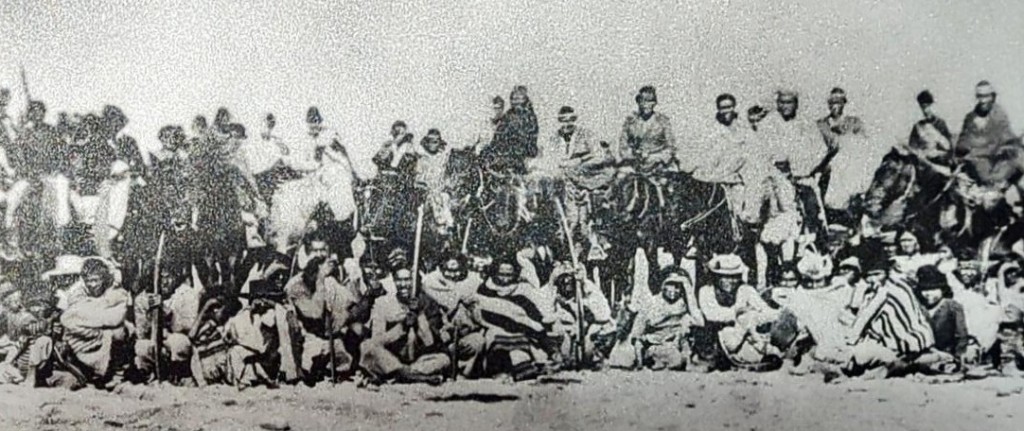Today’s quote:
“The men are to be slain whenever and wherever they can be found; if they beg for peace, their chiefs and twenty of their principal men must come to Santa Fe to have a talk here…”
Brigadier General James H. Carleton, 1862
We spent a few hours at Fort Union National Monument, which preserves the remnants of a late 1800’s military fort in Northeast New Mexico. First built to protect trade with Mexico, then rebuilt to protect the Union from the soldiers of slave-holding states, then rebuilt again to ensure that immigrants from America could safely invade and conquer the Native American southwest. For much of the last half of the 19th century it was the hub of military activities in the Southwest.
The remnants of the fort are nothing special. But the story told in the visitor center museum is. It tells not only of the fort itself, but the cultural clashes that caused the fort to be built – a repeat of the story of westward expansion, manifest destiny, perceived racial and cultural superiority, and the resulting conflict between civilizations and cultures.
This time along the Santa Fe Trail.
Quotes from the museum exhibits:
Fort Union troops were instrumental in forcing indigenous peoples into treaties that restricted their movements. By the 1870s, many tribes in the New Mexico region had been pushed onto reservations. US policies forced children to leave their families to be assimilated into Anglo ways.
Several quotes describe aspects of the conflict:
In 1846, General Stephen Watts Kearny claimed the New Mexican territory for the United States. Some Pueblo and Hispano communities rebelled. The revolt was put down swiftly. Colonel Sterling Price laid siege to the Taos Pueblo, killing over 150 Indians and Hispanos.
And:
The tribes that followed the buffalo moved freely through vast grasslands. By slaughtering the buffalo, Anglo newcomers made this nomadic life impossible. The US Army was tasked with relocating the southwestern nomadic and semi-nomadic Indians onto reservations.
The resulting conflicts were bloody, extended, and complicated. Utes, Jicarilla and Mescalero Apaches, Kiowas, Navajos, and Comanches fought back and sometimes fought each other to try to keep their freedom. Still, by the early 1880s the days of buffalo hunting had passed.
And:
Between 1863 and 1867, the US military forced 11,500 Navajo prisoners to march to the newly established Bosque Rondo Reservation at Fort Sumner 400 miles away. Only around 8,500 completed the harrowing journey. Most walked, some in chains. Stragglers were shot.
Life at the internment camp was no better, and many died of starvation and disease. Navajo leaders negotiated a new treaty that allowed them to return to a portion of their homeland in 1868. The treaty signing is celebrated every year on June first.
The New Mexico governor:
“The pacification of the Indians is another necessity of the first order, for as you already know the principal wealth of this country is the breeding of livestock, and the warfare of the Indians obstructs this almost completely.”
New Mexican Governor Donaciano Vigil, 1848
…stated his priorities quite well.
The quote from General Carleton could just as well have been spoken today in some parts of the world. Because some men in a particular group commit crimes, we kill all the men in the group. If noncombatants, women and children get in the way? Too bad. They should have made better choices.
We of Western European descent used to think that our ‘Western Civilization’ was superior to Native American civilization – to the point where we condemned, sometimes to death, any Native Americans who disagreed. As we know, a couple of decades after nearly eradicating the native ‘savages’, our civilized European cousins decided to brutally kill millions of each other in WWI’s trenches – for no point other than the pride and ego of a ruling class.
A couple of decades after that catastrophic war between Europeans, a group of Western Europeans decided to murder millions more Europeans because they didn’t like them, and attempted to starve and murder tens of millions of Eastern Europeans because the Western Europeans wanted the ‘living space’ that the Eastern Europeans occupied.
Savages? Who us? Nahh… We’re civilized!
A study of our own history always includes the good. That’s easy. To be complete, we must also include the bad. That’s hard. To learn, we must include the ugly – for it is by learning from the ugly in our past that we make our future better.
We’re slow learners though.

Leave a comment